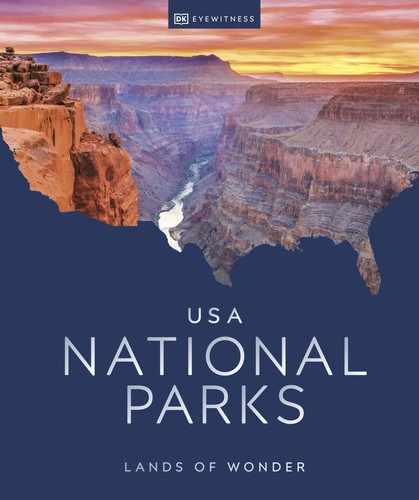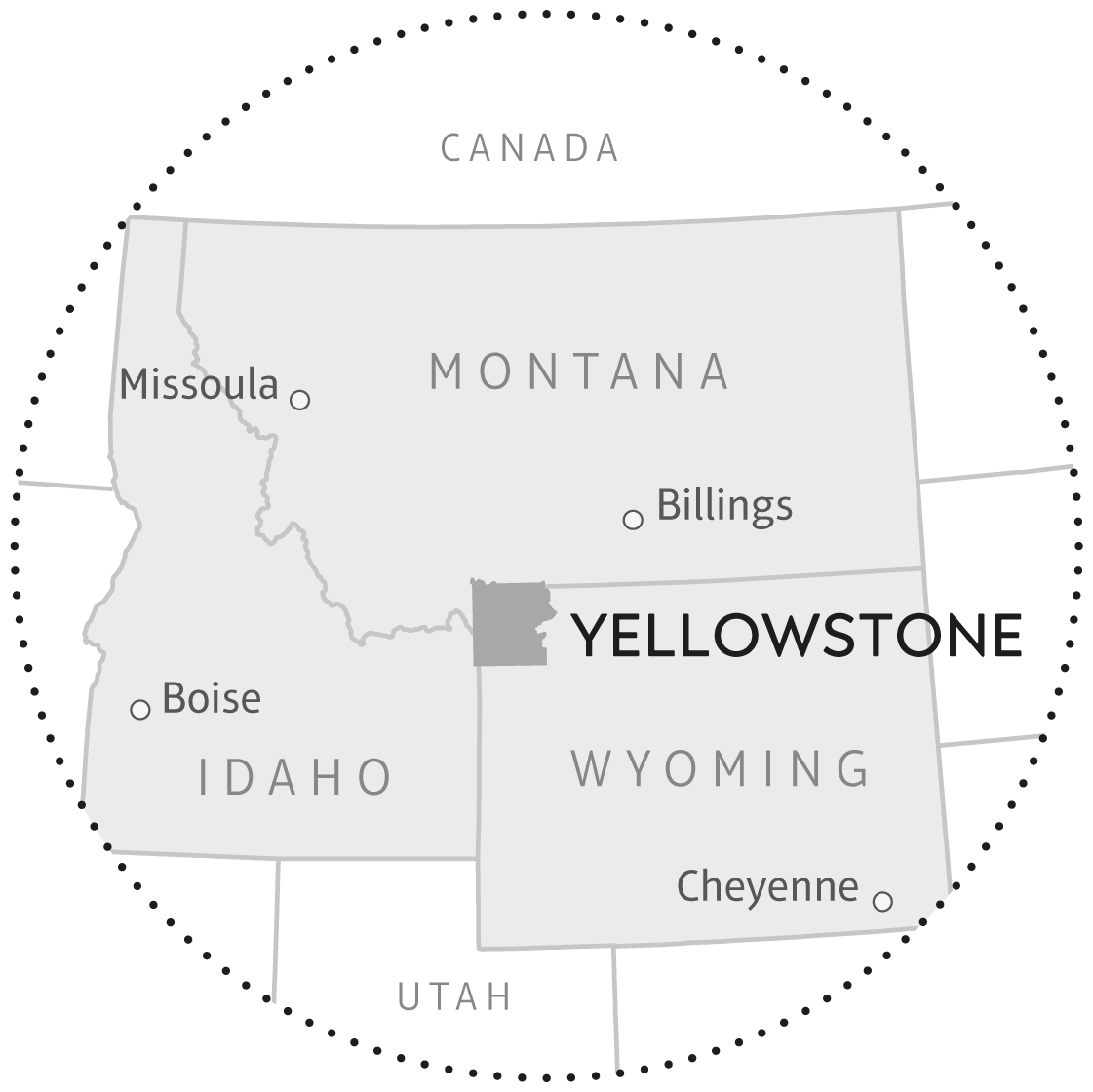
Wyoming • Montana • Idaho
YELLOWSTONE
ESTABLISHED 1872
With gushing geysers, geothermal wonders, a wealth of large wildlife, and superlative Rocky Mountain landscapes, America’s first national park remains one of the most spectacular places in the world.
Set atop a dormant supervolcano, Yellowstone contains more than half the world’s geysers and hydrothermal features. Early 19th-century explorers described it as a place of fire and brimstone, and their reports of boiling mud and petrified trees were dismissed as tall tales or a touch of lunacy. Later, when the unique features and environmental importance of this incredible landscape were realized, Yellowstone became the first national park. In 1978, it was made a UNESCO World Heritage Site.
A wild wonderland
Today, you might describe Yellowstone as nature’s ultimate spa. You can walk amid bubbling mudpots, hissing fumaroles, and sizzling hot springs in a remarkable, otherworldly landscape that glows in the sunlight with seemingly unnatural, fluorescent hues. In some places, the sulfurous smell of rotten eggs will wrinkle your nose. At the park’s many geysers, the underground cauldron erupts in awesome towers of steam that billow into the clouds.
And there’s more. The park comprises several regions, and its geologic wonders include deep, rugged canyons, torrential waterfalls, vast alpine lakes, towering peaks, splendid travertine terraces, and the mighty Yellowstone River. Its forests and grasslands are home to a staggering array of wildlife, including wolves, bears, and the largest public bison herd in the country.
Star showstopper
Yellowstone’s amazing geothermal features are what make this national park unique. And none is more famous than the iconic geyser Old Faithful. Most geysers are unpredictable, but this one, named by explorers in 1870, is one of a handful tracked by park rangers. It erupts about 20 times a day, approximately every 90 minutes, although the intervals can vary up to half an hour. Predicted eruptions are posted at park buildings, or just look out for the gathering crowd.
You’ll have to be quick for a ringside seat at Old Faithful, but the magnificent plume of thundering steam shoots up 185 ft (56 m), an awesome sight stretching far beyond the viewing deck. Each jaw-dropping eruption, which lasts under five minutes, sprays 3,700–8,400 gal (14,000–32,000 l) of boiling water into the sky.
Old Faithful is the star of Yellowstone’s Upper Geyser Basin, but it’s not the biggest in the park. The largest in the world is Steamboat Geyser, with major eruptions that can soar 300–400 ft (90–120 m) high. In fact, there are more than 500 active geysers here, clustered in fascinating geyser basins.
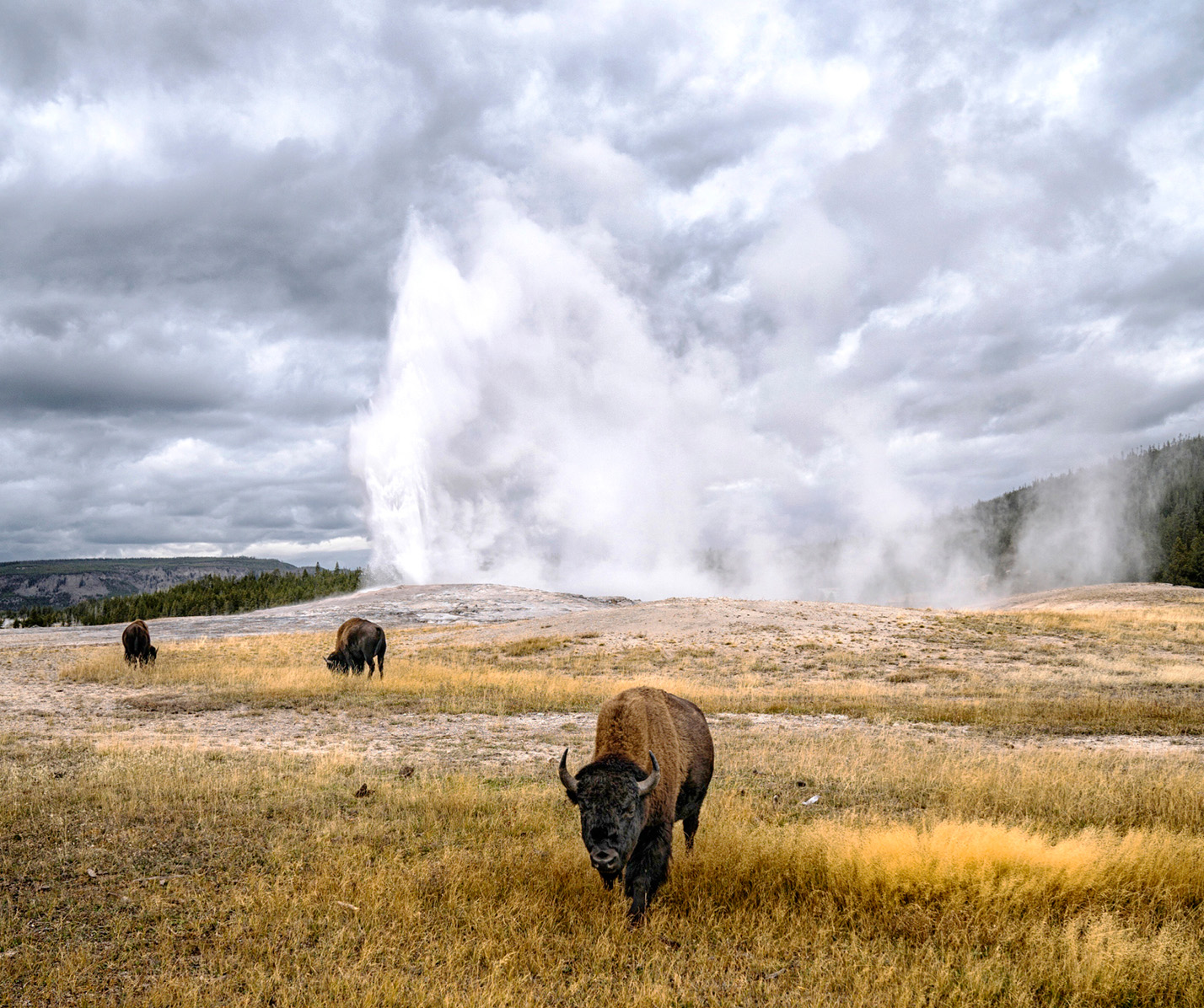
Bison serenely munch on grasses as the geyser Old Faithful waterworks perform behind
Nature’s wizardry
Venturing onto the trails at Norris Geyser Basin, Yellowstone’s hottest and oldest thermal area, is like walking into a wizard’s cauldron. The rank odors of sulfurous gases belch from bubbling mudpots. Minerals and bacteria turn the crust near the roiling hot pools a rainbow of colors. It’s a primeval scene you’ll see nowhere else.
Midway Geyser Basin is home to the world’s third-largest hot spring, the Grand Prismatic Spring, a gigantic sizzling pool of electric blue flanked by fiery bands of orange, yellow, and green. The springs get their dazzling hues from thermophiles, tiny organisms that thrive in the extreme heat. At Roaring Mountain, you’ll hear the hissing of a mountainside covered in steaming fumaroles venting from the netherworld.

Steam rises from the Norris Geyser Basin, even as a snow dusting covers the boardwalk
Did You Know?
The Old Faithful boardwalk contains 3 million recycled plastic milk jugs.
Wildlife Haven |
|
|
Bison have lived here since prehistoric times. In the 1900s, the park was key in bringing them back from near extinction. Today, it provides habitat for other threatened species too: |
|
|
Bison From fewer than 50 individuals in 1902, the free-ranging Yellowstone bison herd now numbers 4,900, the country’s largest bison herd on public lands. The Lamar Valley is the best place to see them. |

|
|
Gray wolves Yellowstone helped ensure the survival of this endangered species when they were reintroduced here in 1995. They now roam freely through the park, and are best seen at sunrise and sunset in the northern range. |
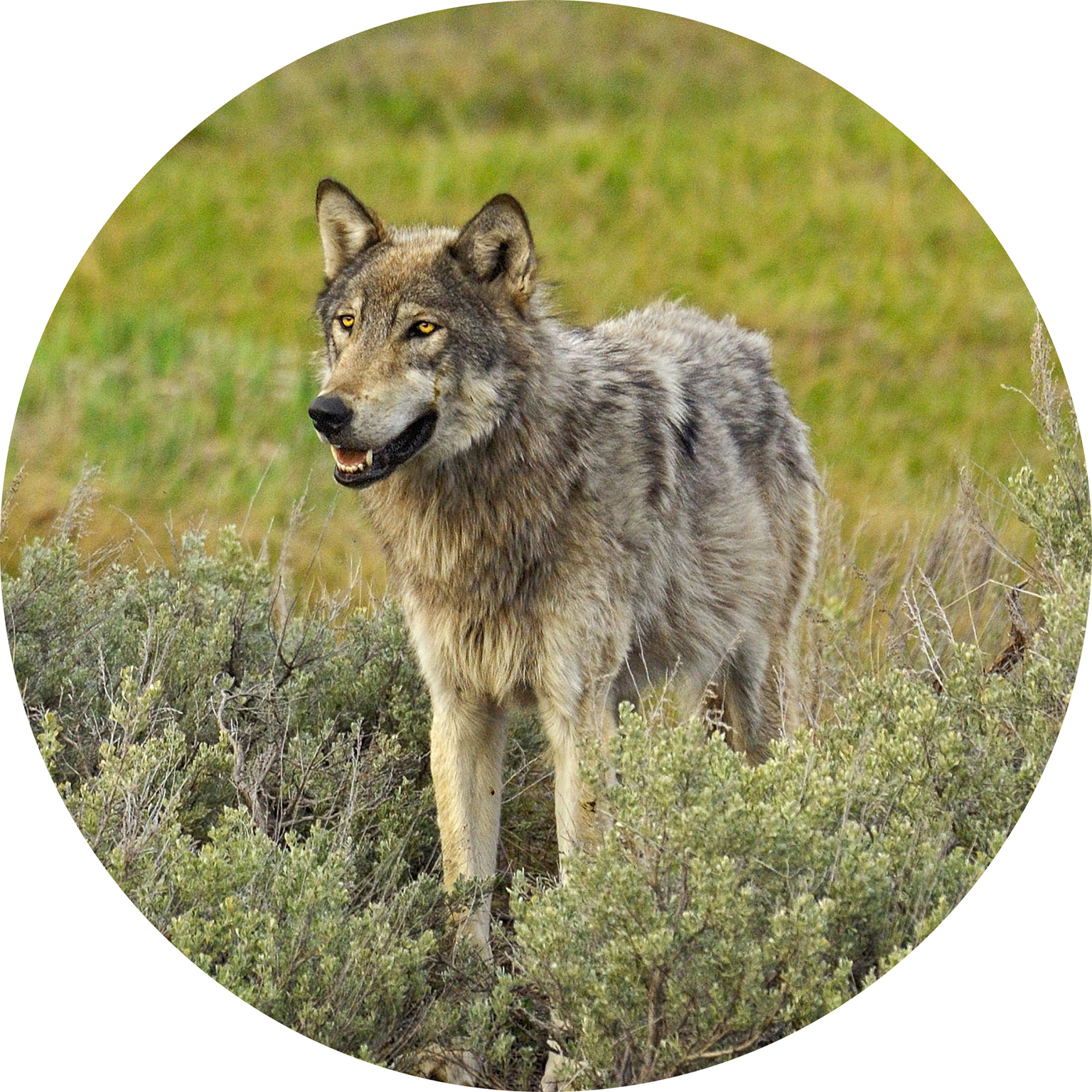
|
|
Grizzly bears The park is one of the last refuges for these awesome bears. Look for them in the Hayden and Lamar valleys, the north slopes of Mount Washburn, and from Fishing Bridge to the east entrance. |
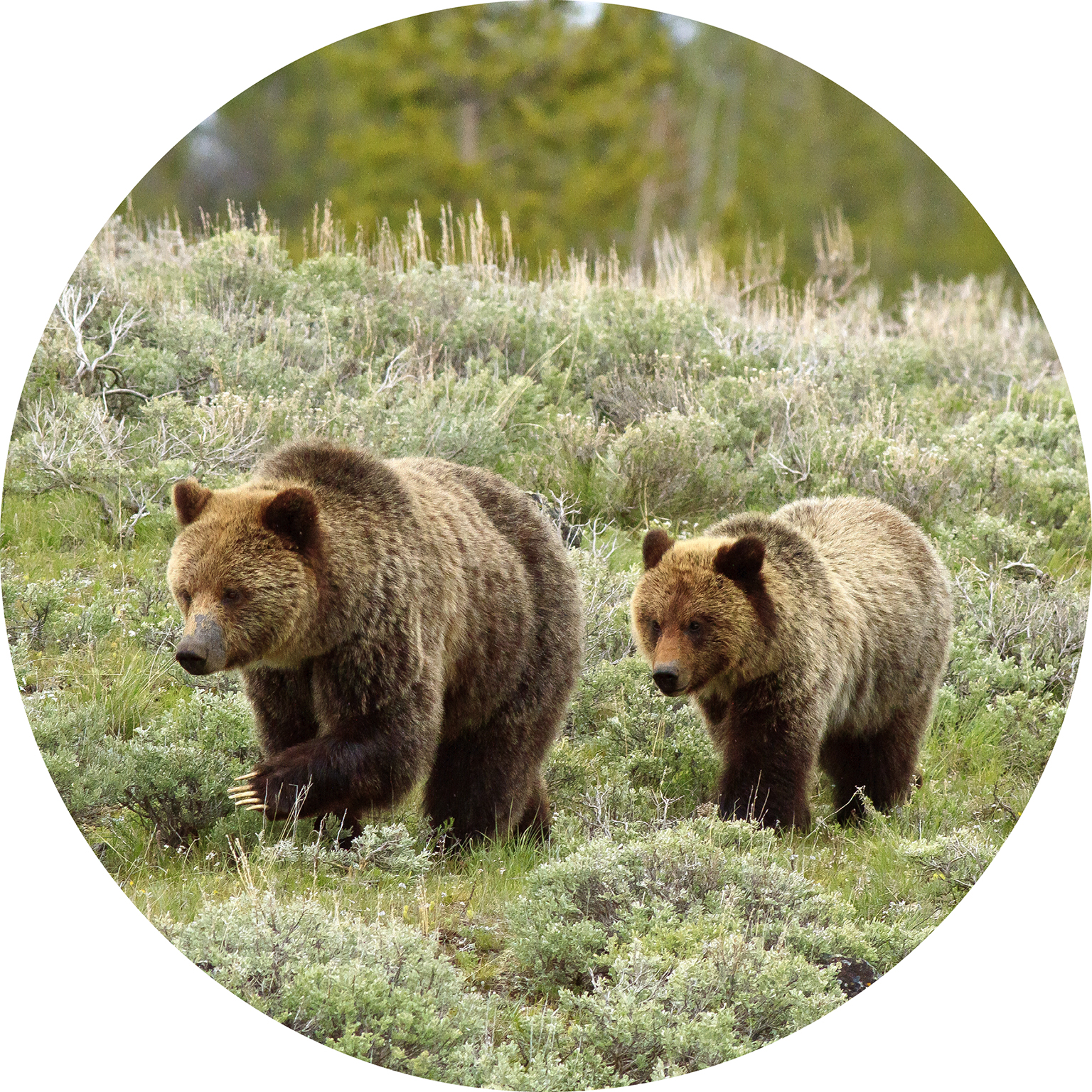
|
|
Canadian lynx Yellowstone provides critical habitat for the elusive Canadian lynx, noted for its silver-brown fur and black-tufted ears. A group lives in the conifer forests and preys on snowshoe hare. |

|
BEST FOR
Cool Places to Stay
Nothing beats the thrill of watching the eruption of the world’s most famous geyser from the hotel sundeck of the Old Faithful Inn. Built in 1903–04, this rustic masterpiece is among the last log hotels in the country, and sports gabled dormers jutting from a seven-story roof, a 65-ft (20-m) rock fireplace in the lobby, pine-railed balconies, and cozy rooms.
World of wildlife
Yellowstone’s spellbinding geyser basins also provide warmth for the park’s wildlife. Bison in particular winter in thermal areas when deep snow covers their summer grazing grounds. Most of the rest of the park is covered in forest, which, along with the grasslands, provides a haven for a vast range of animals and birds.
Yellowstone has the finest habitat for megafauna (large animals) in the Lower 48. Wildlife jams are frequent along park roads, as cars stop to watch bears, moose, and bison. You are likely to see elk and deer and, if lucky, a coyote or wolf running through a clearing. Look for mountain goats and bighorn sheep on rocky ledges. Your best chance of seeing animals of all sizes is on a quiet hiking trail. Wherever you go in the park, wildlife watching is one of Yellowstone’s biggest attractions.
3,472
The size of the park in square miles (8,991 sq km), which is larger than either Rhode Island or Delaware.
900
In miles (1,450 km), the total length of the hiking trails throughout the park.
4
The number of visitors, in millions, that the park welcomes a year.
Endless exploration
If you did nothing more than marvel at Old Faithful and spot some of the park’s wildlife, you would leave Yellowstone happy. But there is so much more to explore.
Perhaps the best way to experience the park is along its vast hiking trails, which wind down into the canyons and up Rocky Mountain peaks standing up to 11,000 ft (3,350 m) high. From these lofty heights, survey the park’s many splendors.
In the center of the park is Yellowstone Lake, one of the world’s largest alpine lakes. As you gaze across its tranquil waters, consider that it was created by a volcanic explosion and the collapse of the Yellowstone caldera 174,000 years ago. Paddle, sail, or cruise onto it from marinas on the shore.
The mighty torrent carves out the Grand Canyon of the Yellowstone. Twenty miles (32 km) long and 1,000 ft (300 m) deep, this narrow cleft reveals layers of geologic color in the rock walls and bursts of steam from hydrothermal features. Take in the views from drives along the north and south rims. Ospreys nest on the canyon’s pinnacles, and you may spy them soaring aloft or feeding their chicks. The canyon ends at the Tower waterfall, which plunges into a hanging valley between lava-rock columns.
In the north of the park, nature has fashioned remarkable travertine terraces at Mammoth Hot Springs. Once again, hydrothermal forces are at play, depositing layer upon layer of dissolved limestone in a staircase of chalky white and burnt orange that resembles a frozen waterfall.

The dense forested walls bring a vivid green to the lower part of the park’s Grand Canyon
![]()
July and August are the best months for camping, when temperatures are warm enough to pitch a tent and sleep under the stars.
Activities in abundance
You can enjoy outdoor pursuits year-round. Licensed outfitters offer guided horseback trips, and during spring and fall, cycling is permitted on designated park roads. In winter, explore a magical wonderland on snowshoes or skis along groomed trails.
Superb fly-fishing for brown and rainbow trout draws anglers from all over, and there are many idyllic rivers where you can cast your line. None is finer than the Yellowstone River, the longest free-flowing river below the Canadian border. From aptly named viewpoints such as Inspiration Point and Artist Point, you’ll have breathtaking vistas of the river plummeting over the Upper Falls and the even larger Lower Falls, its roaring white water like a geyser in reverse.
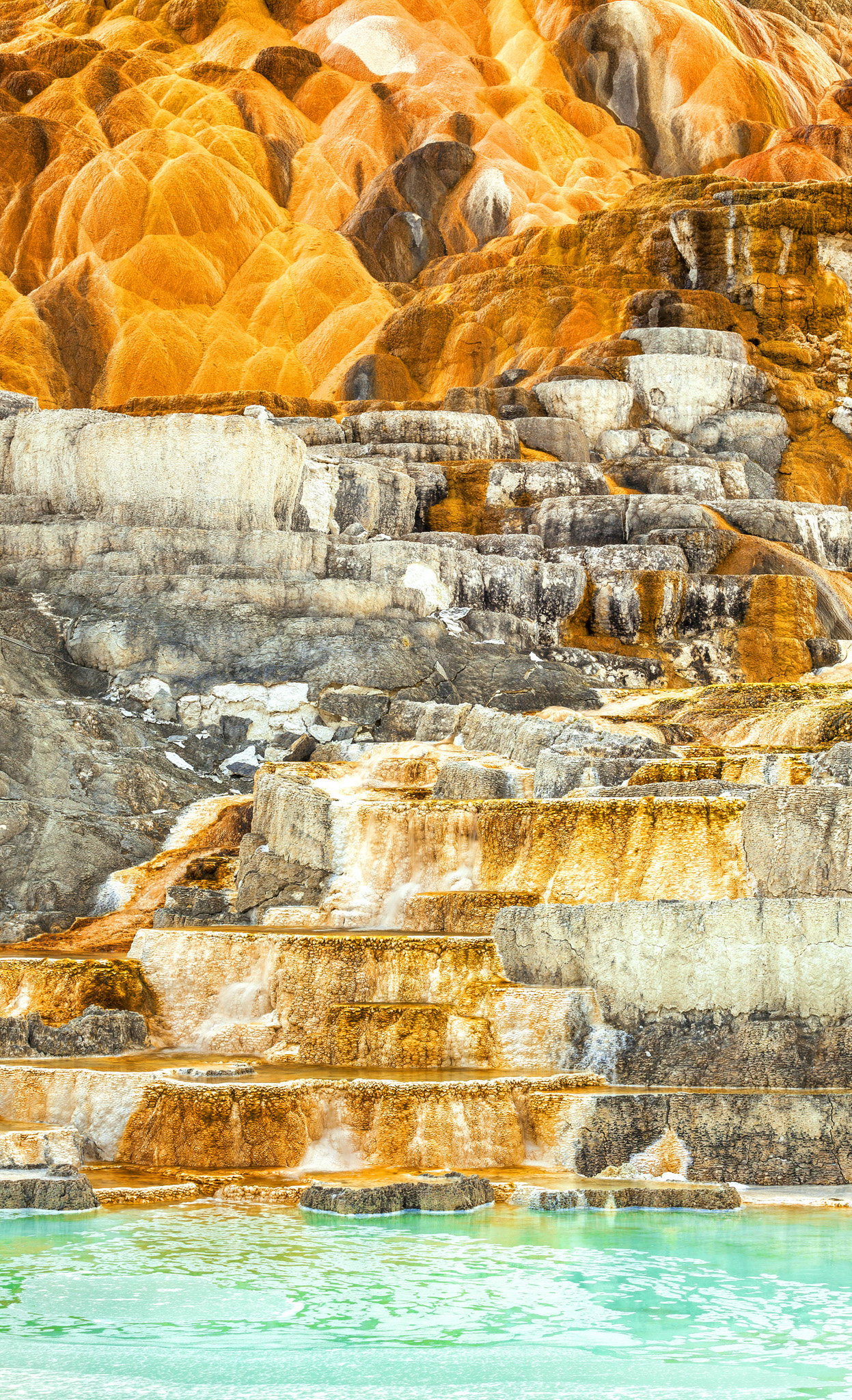
The spectacular Mammoth Hot Springs terraces have been described as an “inside-out cave”
Did You Know?
Yellowstone has more than 10,000 hydrothermal features.
Best Day Hikes

Mountain hike ▷ Bunsen Peak, 4.6 miles (7 km) round trip. A moderately steep switchback trail leads up through meadows and forest to the summit, where there are stunning panoramic views of the Yellowstone River valley.
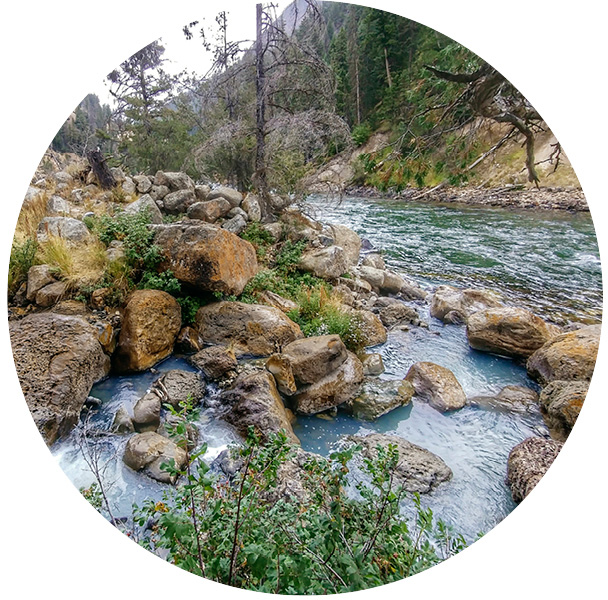
Canyon hike ▷ Seven Mile Hole Trail, 10 miles (16 km) round trip. Enjoy splendid views of Silver Cord Cascade from the canyon rim before descending 1,000 ft (300 m) into the Grand Canyon of the Yellowstone.
Lake hike Yellowstone Lake Overlook Trail, 1.7 miles (2.7 km) round trip. After a steep ascent that passes thermal features, you’ll reach a high mountain meadow with grand views over the West Thumb area of the lake.
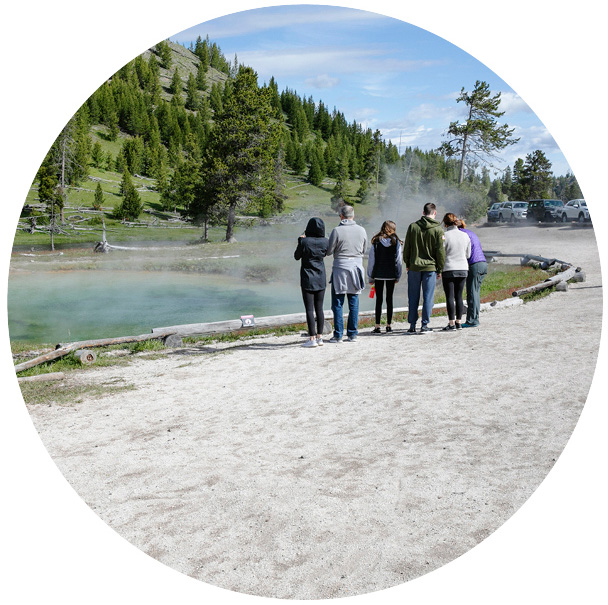
Waterfall and geysers hike ▷ Fairy Falls Trail, 6.7 miles (11 km) round trip. Hike to one of the park’s finest waterfalls, then carry on past steaming hot springs to Spray and Imperial geysers.
FOCUS ON
Forces of Nature
Yellowstone sits above two vast bodies of magma (molten rock), lying miles under the surface. The superhot temperatures heat the groundwater, which bubbles up as pressure builds. Geysers form when narrow underground chambers constrict the water, which reaches temperatures of 244°F (118°C). Once the pressure is too great, it sends the pent-up steam and boiling water bursting out of the earth in a dramatic plume.

Its almost psychedelic colors make Grand Prismatic Spring a photographer’s dream
